north carolina
 As the door closes on past eras of history, some things only exist in the memories of the people who lived it, and some things only exist in books or other writings. That doesn’t mean that they totally cease to exist, however. There are parts of the past that are still there…hidden, sometimes just under the surface, and sometimes a little way beneath the surface. Sometimes, there are clues on the surface, and other times, all you might have is a general location. Such is the case with Fort San Juan in western North Carolina. In 1566, Spanish explorer Juan Pardo began the first of two expeditions along the southeast coast of North America, establishing a series of forts in modern day South Carolina. The following year, Pardo travelled west, journeying almost 300 miles into what is now North Carolina. There, Pardo and his men constructed Fort San Juan and a small cluster of houses. Pardo named the settlement Cuenco, after his Spanish hometown.
As the door closes on past eras of history, some things only exist in the memories of the people who lived it, and some things only exist in books or other writings. That doesn’t mean that they totally cease to exist, however. There are parts of the past that are still there…hidden, sometimes just under the surface, and sometimes a little way beneath the surface. Sometimes, there are clues on the surface, and other times, all you might have is a general location. Such is the case with Fort San Juan in western North Carolina. In 1566, Spanish explorer Juan Pardo began the first of two expeditions along the southeast coast of North America, establishing a series of forts in modern day South Carolina. The following year, Pardo travelled west, journeying almost 300 miles into what is now North Carolina. There, Pardo and his men constructed Fort San Juan and a small cluster of houses. Pardo named the settlement Cuenco, after his Spanish hometown.
In 2013, a team of archeologists announced the discovery of the remains of a long lost 16th century Spanish garrison in western North Carolina that predates the earliest English settlements in North America by decades. Established in 1567, Fort San Juan was just one of at least six military installations built by the Spanish across the Appalachian mountain range, stretching from the coast of South Carolina to eastern Tennessee, and the only one of the forts scientists have located so far. Because Fort San Juan was established in 1567, time had taken its toll, and the information about it’s location was scarce, as was any visible trace of its location. Fort San Juan was one of at least six military installations that were built by the Spanish across the Appalachian mountain range, stretching from the coast of South Carolina to eastern Tennessee…and the only one of the 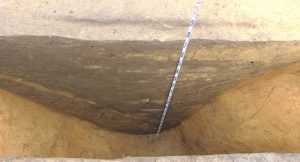 forts scientists have been able to locate so far. In the summer of 2013, a team of archeologists announced the discovery of the fort’s remains.
forts scientists have been able to locate so far. In the summer of 2013, a team of archeologists announced the discovery of the fort’s remains.
Archaeological work has been underway for years, revealing artifacts that suggested a Spanish settlement might have been there. During the summer of 2013, archaeologists affiliated with the University of Michigan, Tulane University and Warren Wilson College excitedly announced that they had discovered evidence of a defensive moat and other remains, definitive evidence of Fort San Juan. Nearly a decade ago, archeologists had found evidence of the soldier’s housing at Cuenco, but had been had not been able to locate the fort itself. The summer of 2013 changed all that, and was in fact it was completely by accident. The team, comprised of members from the University of Michigan, New Orleans’s Tulane University and Warren Wilson College in Asheville, North Carolina, was actually researching the Mississippian built mud mounds at the Joara site when they stumbled upon evidence of the remains of the fort. An initial dig turned up soil disturbances at the site that didn’t fit with what they expected. The team brought in a magnetometer to x-ray the subsurface. This 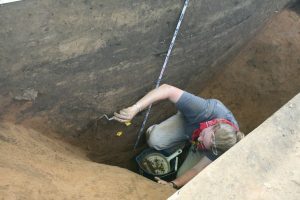 allowed them to identify the outlines of the moat was believed to have surrounded the garrison. Additional large scale excavations revealed its shape and size. A V-shaped area 5.5 feet deep, 12 to 15 feet across and up to 100 feet in length. In addition to the moat, the team recovered personal items belonging to the Spanish soldiers who lived and died at the fort, including pottery shards, nails, tacks, and iron hooks used for fastening clothing and swords. They also believe they located the gravel entry path into the garrison and the possible location of the strong house in a corner of the fort, where Spanish soldiers would have stored tools and weaponry. The group plans further excavations of the site next year.
allowed them to identify the outlines of the moat was believed to have surrounded the garrison. Additional large scale excavations revealed its shape and size. A V-shaped area 5.5 feet deep, 12 to 15 feet across and up to 100 feet in length. In addition to the moat, the team recovered personal items belonging to the Spanish soldiers who lived and died at the fort, including pottery shards, nails, tacks, and iron hooks used for fastening clothing and swords. They also believe they located the gravel entry path into the garrison and the possible location of the strong house in a corner of the fort, where Spanish soldiers would have stored tools and weaponry. The group plans further excavations of the site next year.

 My niece, Lindsay Moore, is a social butterfly. She never had any trouble making new friends, and everyone who knows her, loves her. It’s a personality trait that Lindsay has. She can talk to anyone…and feel no shyness, and her friendship ability is coupled with her genuine caring nature. I remember when she was a teenager, and I would see her at church, before the service, talking to some of the other members of the congregation. It didn’t matter how old they were, or how young, Lindsay could talk to any of them. I always found the way she was when talking to some of the older members of the congregation to be the sweetest thing to watch. I remember when she was talking to a woman named Fern one time. I’m not sure how old Fern was at the time, but at least mid-seventies I would think. Lindsay went up and hugged her and then sat down to visit with her for a minute. Fern was obviously pleased that this teenager cared enough to talk to her, but it was also obvious that it wasn’t their first conversation. They were talking like friends, because they were friends. I know that Lindsay was just being Lindsay, but I can tell you that her actions affected more than one person in church that day. Fern, of course was very blessed by the sweet, loving girl who was sharing a moment with her, but there were others too. I noticed several other members of the congregation looking on with a sense of…well, pride, almost as if they had something to do with how Lindsay had turned out. They didn’t, of course, but she was a member of the church, and that gave them a sense of family, and therefore pride at how kind she was to Fern. For me…well, it was a picture that has been stored in my memory files since that day. Her way of making people feel important is something I’ll never forget about Lindsay.
My niece, Lindsay Moore, is a social butterfly. She never had any trouble making new friends, and everyone who knows her, loves her. It’s a personality trait that Lindsay has. She can talk to anyone…and feel no shyness, and her friendship ability is coupled with her genuine caring nature. I remember when she was a teenager, and I would see her at church, before the service, talking to some of the other members of the congregation. It didn’t matter how old they were, or how young, Lindsay could talk to any of them. I always found the way she was when talking to some of the older members of the congregation to be the sweetest thing to watch. I remember when she was talking to a woman named Fern one time. I’m not sure how old Fern was at the time, but at least mid-seventies I would think. Lindsay went up and hugged her and then sat down to visit with her for a minute. Fern was obviously pleased that this teenager cared enough to talk to her, but it was also obvious that it wasn’t their first conversation. They were talking like friends, because they were friends. I know that Lindsay was just being Lindsay, but I can tell you that her actions affected more than one person in church that day. Fern, of course was very blessed by the sweet, loving girl who was sharing a moment with her, but there were others too. I noticed several other members of the congregation looking on with a sense of…well, pride, almost as if they had something to do with how Lindsay had turned out. They didn’t, of course, but she was a member of the church, and that gave them a sense of family, and therefore pride at how kind she was to Fern. For me…well, it was a picture that has been stored in my memory files since that day. Her way of making people feel important is something I’ll never forget about Lindsay.
Lindsay has had the opportunity to live a number of places in her life. She was born in Casper, Wyoming, but has lived in South Dakota, Florida, and North Carolina. Her husband’s work as a college special teams coach also gives them the opportunity to travel to recruit players, so she has been a lot of places. I’ve often wondered if the moves were difficult. Being somewhat shy, myself, it is hard for me to imagine making new 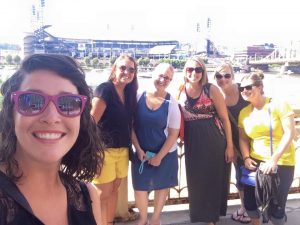
 friends every time another move was necessary, but Lindsay really has no trouble. Everywhere she has lived, she makes new friends quickly. Then when she has to move, she remains friends with the people she has met…for life. I think it all goes back to that ability to share a moment with people. Then moments turn into a friendship that forms because Lindsay genuinely cares about people, and people want to be friends with people like that. Today is Lindsay’s birthday. Happy birthday Lindsay!! Have a great day!! We love you!!
friends every time another move was necessary, but Lindsay really has no trouble. Everywhere she has lived, she makes new friends quickly. Then when she has to move, she remains friends with the people she has met…for life. I think it all goes back to that ability to share a moment with people. Then moments turn into a friendship that forms because Lindsay genuinely cares about people, and people want to be friends with people like that. Today is Lindsay’s birthday. Happy birthday Lindsay!! Have a great day!! We love you!!
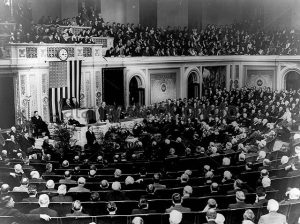
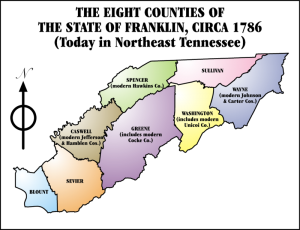 Have you heard of the nation of Frankland…or maybe the nation of Franklin? I hadn’t either, but it was a real place. Early in the history of the United States, its people operated on somewhat limited trust of the government…probably due to the treatment they received in England. In April of 1784, the state of North Carolina ceded its western land claims between the Allegheny Mountains and the Mississippi River to the United States Congress. The settlers who lived in that area, known as the Cumberland River Valley, had already formed their own government from 1772 to 1777, and their distrust of Congress led the to worry that the area might be sold to Spain or France to pay off war debts owed them by the government. Due to their concerns, North Carolina retracted its cession and started to organize an administration for the territory.
Have you heard of the nation of Frankland…or maybe the nation of Franklin? I hadn’t either, but it was a real place. Early in the history of the United States, its people operated on somewhat limited trust of the government…probably due to the treatment they received in England. In April of 1784, the state of North Carolina ceded its western land claims between the Allegheny Mountains and the Mississippi River to the United States Congress. The settlers who lived in that area, known as the Cumberland River Valley, had already formed their own government from 1772 to 1777, and their distrust of Congress led the to worry that the area might be sold to Spain or France to pay off war debts owed them by the government. Due to their concerns, North Carolina retracted its cession and started to organize an administration for the territory.
At the same time, representatives from Washington, Sullivan, Spencer (modern-day Hawkins) and Greene  counties declared their independence from North Carolina. Then, in May, they petitioned the United States Congress for statehood as Frankland. The simple majority favored the petition, but Congress could not get the two thirds majority to pass it…not even when the people decided to change the name to Franklin, in the hope of winning favor with Benjamin Franklin and some of the others.
counties declared their independence from North Carolina. Then, in May, they petitioned the United States Congress for statehood as Frankland. The simple majority favored the petition, but Congress could not get the two thirds majority to pass it…not even when the people decided to change the name to Franklin, in the hope of winning favor with Benjamin Franklin and some of the others.
When the petition failed to pass, the people in the area grew angry, and decided to defy Congress. On this day, August 23, 1784, they ceded from the union and functioned as the Free Republic of Franklin (Frankland) for four years. During that time, they had their own constitution, Indian treaties and legislated system of barter in lieu of currency. Two years into the Free Republic of Franklin’s history, North Carolina set up their own parallel government in the area. The economy was weak, and never really gained ground, so the governor, John Sevier approached the Spanish for aid. That move brought a feeling of terror in the government of North Carolina, and they arrested Sevier. The situation worsened when the Cherokee, Chickamauga and Chickasaw began to attack settlements within Franklin’s borders in 1788. Franklin quickly rejoined North Carolina to gain its militia’s protection from attack.
It was a short life for the little nation of Franklin, and eventually they wouldn’t even belong to North Carolina, but rather became a part of the state of Tennessee. It just goes to show that the growing pains of a nation can  take on many forms to reach their destiny as a whole nation. Some changes are good ones, and continue on into the future, and others are not so good, and are sometimes absorbed into the fabric of history and time, and end up looking nothing like the change they started out to be.
take on many forms to reach their destiny as a whole nation. Some changes are good ones, and continue on into the future, and others are not so good, and are sometimes absorbed into the fabric of history and time, and end up looking nothing like the change they started out to be.
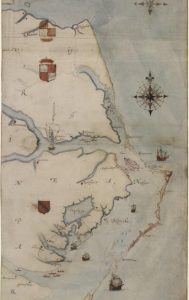 When I think of a lost people, I think of a tribe in Africa or somewhere very isolated, but I never think of someplace in America! Nevertheless, it happened right here in America. Of course, it was a long…long time ago. It was long before people could easily track someone down. The year was 1587, the day was July 22. That was the day when the new colony arrived in Roanoke, North Carolina, which was colonial Virginia. On August 18, 1587, the first English baby to be born in the Americas, Virginia Dare was born. The group had been dispatched by Sir Walter Raleigh, and was led by John White, who by the way, was Virginia Dare’s grandfather. Upon their arrival, they found nothing of the English garrison that had gone ahead, except one skeleton. The people really didn’t want to stay there after that, but the fleet commander, Simon Fernandez would not let them return to the ship, and the ships sailed with the promise of new supplies to come.
When I think of a lost people, I think of a tribe in Africa or somewhere very isolated, but I never think of someplace in America! Nevertheless, it happened right here in America. Of course, it was a long…long time ago. It was long before people could easily track someone down. The year was 1587, the day was July 22. That was the day when the new colony arrived in Roanoke, North Carolina, which was colonial Virginia. On August 18, 1587, the first English baby to be born in the Americas, Virginia Dare was born. The group had been dispatched by Sir Walter Raleigh, and was led by John White, who by the way, was Virginia Dare’s grandfather. Upon their arrival, they found nothing of the English garrison that had gone ahead, except one skeleton. The people really didn’t want to stay there after that, but the fleet commander, Simon Fernandez would not let them return to the ship, and the ships sailed with the promise of new supplies to come.
John White was not allowed to stay, and so returned to England on August 27, 1587…vowing to return in three months time. That was about the time of the Spanish Armada attack in 1588, which delayed White’s return to Roanoke. White tried desperately to return to the little colony for the next three years. When he was finally able to get there, he came rushing onshore, only to find that the colony was gone. 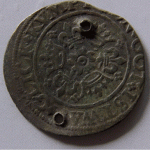
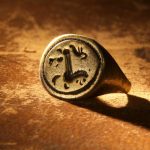 Among those missing was the little girl, Virginia Dare, White’s granddaughter. They had arrived on what would have been her third birthday…August 15. Whites return was delayed because of the Anglo-Spanish war, and the Spanish ships that robbed the expedition of the supplies they were taking over to the colonists. It is suspected that the colony disappeared during that war, but there is no clear clarification as to where they went or who took them.
Among those missing was the little girl, Virginia Dare, White’s granddaughter. They had arrived on what would have been her third birthday…August 15. Whites return was delayed because of the Anglo-Spanish war, and the Spanish ships that robbed the expedition of the supplies they were taking over to the colonists. It is suspected that the colony disappeared during that war, but there is no clear clarification as to where they went or who took them.
There has been much speculation as to the fate of the Roanoke Lost Colony, but the sure fate of the settlers left behind is unknown and the colony is known as the “Lost Colony” of Roanoke to this day. Over the years numerous attempts have been made to find the Lost Colony, including the Lost Colony DNA Project started in 2005. Recent investigations speculate that the Lost Colony relocated to where the Chowan River meets the Albemarle Sound in present day Bertie County, North Carolina. Nevertheless, recent discoveries found 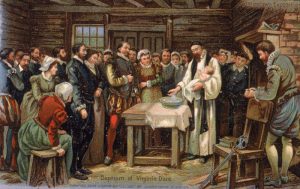 European objects in the Hatteras Island area, including a sword hilt, broken English bowls, and a fragment of a slate writing tablet still inscribed with a letter. These could point to the presence of the colonists on Hatteras Island, some 50 miles southeast of their settlement on Roanoke Island. There were also some found at a site on the mainland 50 miles to the northwest. Some people have thought that the Native Americans took the people or at least assimilated them into their tribe, because there are in some of that modern day tribe of people with strangely gray eyes. I suppose we will never really know the reality of what happened, but I would rather think that the Native Americans took them in, than to think that they were killed.
European objects in the Hatteras Island area, including a sword hilt, broken English bowls, and a fragment of a slate writing tablet still inscribed with a letter. These could point to the presence of the colonists on Hatteras Island, some 50 miles southeast of their settlement on Roanoke Island. There were also some found at a site on the mainland 50 miles to the northwest. Some people have thought that the Native Americans took the people or at least assimilated them into their tribe, because there are in some of that modern day tribe of people with strangely gray eyes. I suppose we will never really know the reality of what happened, but I would rather think that the Native Americans took them in, than to think that they were killed.
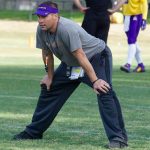
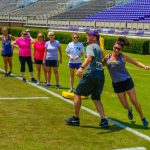 My nephew, Shannon Moore, who joined our family when he married my niece, Lindsay Hadlock Moore on Valentines Day, 2014, is the Special Teams Coordinator and Tight Ends coach at East Carolina University…home of the Pirates. Prior to being hired on at East Carolina University, Shannon was the Special Teams coach at Miami International University. The move to East Carolina University was a definite move up for Shannon, and Greenville, North Carolina, where the University is located is a real football town…quite a change from Miami, where the beach was more important than football. Greenville even has the ECU Ladies Football Clinic, which is really a football camp for women. To see Lindsay and Shannon interacting on the football field is a little strange, and from the looks on the faces of the other women, I think it might be an interaction that the other ladies might not consider, since it looks like Lindsay takes advantage of the fact that
My nephew, Shannon Moore, who joined our family when he married my niece, Lindsay Hadlock Moore on Valentines Day, 2014, is the Special Teams Coordinator and Tight Ends coach at East Carolina University…home of the Pirates. Prior to being hired on at East Carolina University, Shannon was the Special Teams coach at Miami International University. The move to East Carolina University was a definite move up for Shannon, and Greenville, North Carolina, where the University is located is a real football town…quite a change from Miami, where the beach was more important than football. Greenville even has the ECU Ladies Football Clinic, which is really a football camp for women. To see Lindsay and Shannon interacting on the football field is a little strange, and from the looks on the faces of the other women, I think it might be an interaction that the other ladies might not consider, since it looks like Lindsay takes advantage of the fact that 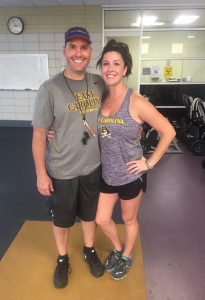 she is married to the coach. I’m sure the other ladies actually got a kick out of it, because Lindsay and Shannon can be very funny when they get going. And I think that Shannon kind of enjoyed the whole coaching the women thing too.
she is married to the coach. I’m sure the other ladies actually got a kick out of it, because Lindsay and Shannon can be very funny when they get going. And I think that Shannon kind of enjoyed the whole coaching the women thing too.
Along with football, Shannon likes to do most of the guys things…like camping. I’m not sure how much camping he did before he met Lindsay, but since her parents have a place on Casper Mountain, he has come to really enjoy it. Now with summer upon us, and his work less busy, he and Lindsay have been exploring the Greenville area. The other nice thing about having more time in the summer, is that they can make trips home to see the family. The spent a week in Nebraska camping with Shannon’s family, and will be coming here this week for camping and a family wedding. We all look forward to seeing them again.
Shannon finally has a big garage again, after a number of years without one. Apparently, he is quite handy with the carpentry tools. His garage has become the carpentry shop. He built Lindsay a standing desk for her office. She works from home, and doesn’t like sitting all day. He also built a pallet bed for one of their guest 
 rooms. I hadn’t really seen a pallet bed that had a finished look before, and I must say that Shannon is quite good and what he does. His work is amazing, and innovative. Lindsay says he is also quite handy at projects around the house, whether it’s yard work or building something. He just loves it. As Lindsay says, “It must be a man thing.” She also says that he is quite busy being an amazing husband…biased…maybe a little, but we all love Shannon, so we have to agree. Today is Shannon’s birthday. Happy birthday Shannon!! Have a great day!! We love you!!
rooms. I hadn’t really seen a pallet bed that had a finished look before, and I must say that Shannon is quite good and what he does. His work is amazing, and innovative. Lindsay says he is also quite handy at projects around the house, whether it’s yard work or building something. He just loves it. As Lindsay says, “It must be a man thing.” She also says that he is quite busy being an amazing husband…biased…maybe a little, but we all love Shannon, so we have to agree. Today is Shannon’s birthday. Happy birthday Shannon!! Have a great day!! We love you!!
 It all started in the late 1990s, in church. That was when two girls, my cousin, Julie Carlson Soukup and her friend, Melody Cox sang together, and found out that they had a God given musical bond. They found that Julie’s words combined with and complimented Melody’s music. Before long they had put together enough songs to record an album. In 1999, Crush Girls was born when the girls recorded their first album, Broken Dove, at Inland Sea Studios in nearby Superior, Wisconsin.
It all started in the late 1990s, in church. That was when two girls, my cousin, Julie Carlson Soukup and her friend, Melody Cox sang together, and found out that they had a God given musical bond. They found that Julie’s words combined with and complimented Melody’s music. Before long they had put together enough songs to record an album. In 1999, Crush Girls was born when the girls recorded their first album, Broken Dove, at Inland Sea Studios in nearby Superior, Wisconsin.
Julie and Melody knew that they had something special, but that’s not enough to grab the attention of the masses. For that you have to be extraordinary. That’s what Julie and Melody were…extraordinary. Before long Crush Girls had built a level of notoriety that allowed them to perform “some very cool gigs” as Melody would say. They played for the Governor of Minnesota, Jesse Ventura and his staff in a formal setting, and then the staff stayed to continue to enjoy the music around a campfire after the governor and his wife went to bed. They played during  the Blue Angels Show in Duluth, Minnesota, the Harley Davidson Multiple Sclerosis Charity, and the Great American Heartwalk. They had a standing engagement as the house concert group for several months at Giant’s Ridge Golf and Ski Resort, as well as well as regular engagements around the Duluth area, including the Homegrown Festival. Their music continued to grow, and the girls recorded a couple of demos back at the Inland Sea Studios, including headlining song Candy Kisses, which became a crowd favorite.
the Blue Angels Show in Duluth, Minnesota, the Harley Davidson Multiple Sclerosis Charity, and the Great American Heartwalk. They had a standing engagement as the house concert group for several months at Giant’s Ridge Golf and Ski Resort, as well as well as regular engagements around the Duluth area, including the Homegrown Festival. Their music continued to grow, and the girls recorded a couple of demos back at the Inland Sea Studios, including headlining song Candy Kisses, which became a crowd favorite.
As with most things, time stepped in and the girls’ took different paths for a time…a time which Melody called “Crush, the Dark Years.” Nevertheless, she says that Julie and their music were certainly never far from her mind. Melody missed Julie and their musical “children.” She continued to play gigs and always included songs from Crush Girls in the set list. Then, time stepped in again and the music resonated in Julie again. The girls reconnected and have been writing again, but on a deeper and more sincere level. The girls still live a few hundred miles apart…Julie in Duluth, Minnesota and Melody in Asheville, North Carolina, but Melody says that Julie will always be her heart’s twin, with the first cut of their Broken Dove album, I Begin In You as their core. She truly believes that their music will continue and will find a way, and I think determination will bring it to pass.

I tend to agree with Melody, because I don’t think Crush Girls are over. Their latest song, Shores Evermore is the expression of the music finding a way. They are making plans to take some time to step back into the studio. As Melody says, “Much more is stirring in the Crush breeze! So stay tuned ~ more Crush songs are coming!” Having taken the time to listen to some of their songs, I can tell you that each and every one is worth waiting for. I think God certainly knew what He was doing when He joined these two musical hearts together. I hope they will indeed find a way to make more of their music, because I think a lot of people would really enjoy it if they did.
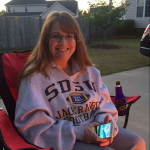 When my niece, Lindsay Hadlock Moore’s husband Shannon took a position as Special Teams Coordinator at East Carolina University, it meant that they would be moving from the Miami area of Florida to Greenville, North Carolina. That also meant that in due time, my sister, Allyn Spencer Hadlock and her husband, Chris would be traveling to visit their kids in their new home. That time came this week, when Allyn flew out last Saturday, and Chris joined them on Wednesday after a work related trip to Chicago. As Allyn was getting ready to fly out, she sent out a text to the rest of my sisters and me to let us know that she was leaving and when she would be back.
When my niece, Lindsay Hadlock Moore’s husband Shannon took a position as Special Teams Coordinator at East Carolina University, it meant that they would be moving from the Miami area of Florida to Greenville, North Carolina. That also meant that in due time, my sister, Allyn Spencer Hadlock and her husband, Chris would be traveling to visit their kids in their new home. That time came this week, when Allyn flew out last Saturday, and Chris joined them on Wednesday after a work related trip to Chicago. As Allyn was getting ready to fly out, she sent out a text to the rest of my sisters and me to let us know that she was leaving and when she would be back.
Of course, in our family of jokesters, it had to happen. Our sister, Cheryl Spencer 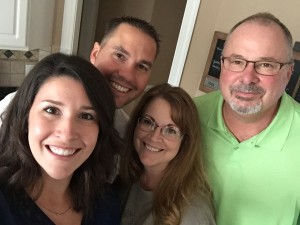 Masterson made the comment that Allyn, who would be landing in Raleigh, would be flying into Andy Griffith Land. I laughed, and Allyn commented, “Yay, Mayberry.” Then she said that, of course, Lindsay actually lives in Greeneville, North Carolina, or more correctly, a suburb called Winterville…to which I commented, “Sounds like Mayberry to me.” and Cheryl commented, ” Greenville, Mayberry. Pretty close!” If you will recall, the big city that everyone went to on The Andy Griffith Show, was Raleigh…which got the whole conversation going in the first place. Mayberry, of course, was a fictional town based on Mount Airy, which is Andy Griffith’s hometown. Mount Airy is three and a half hours west of Winterville, and a place that maybe the family will go see someday, since there are a number of Andy Griffith related sights to see there, such as Andy Griffith’s house, the Andy Griffith Museum, the Mayberry Fountain, and the Mayberry Campground, and several more I’m sure.
Masterson made the comment that Allyn, who would be landing in Raleigh, would be flying into Andy Griffith Land. I laughed, and Allyn commented, “Yay, Mayberry.” Then she said that, of course, Lindsay actually lives in Greeneville, North Carolina, or more correctly, a suburb called Winterville…to which I commented, “Sounds like Mayberry to me.” and Cheryl commented, ” Greenville, Mayberry. Pretty close!” If you will recall, the big city that everyone went to on The Andy Griffith Show, was Raleigh…which got the whole conversation going in the first place. Mayberry, of course, was a fictional town based on Mount Airy, which is Andy Griffith’s hometown. Mount Airy is three and a half hours west of Winterville, and a place that maybe the family will go see someday, since there are a number of Andy Griffith related sights to see there, such as Andy Griffith’s house, the Andy Griffith Museum, the Mayberry Fountain, and the Mayberry Campground, and several more I’m sure.
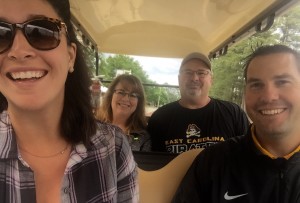
Of course, Andy Griffith…as much as we all loved him, was not the reason that Allyn and Chris traveled to Winterville, North Carolina. That honor belongs to their daughter and son-in-law, and now they are having a great time touring the campus of East Carolina University, and just spending quality time with their kids. It is always hard to have some of your kids living so far away, and you find yourself really looking forward to trips to see them, and their trips home to see you. they are having the time of their lives visiting, and really the only thing that has in common with Andy Griffith…is that this reunion is taking place in Andy Griffith Land.
 People always seem to be in a hurry. We encounter cars that fly past us trying to get to their destination on time, when they really didn’t allow enough time for the trip. We are all guilty of running late, and even of speeding to make it on time, and as we all know, sometimes our habit of running late and being in such a hurry, can have bad consequences. Sometimes the consequences of running late can be devastating. Such was the case with Old 97, a mail train for Southern Railways. While it’s number was simply number 97, and it was officially known as the Fast Mail, its nickname was Old 97. The train ran from Washington DC to Atlanta, Georgia. On September 27, 1903 it was en route from Monroe, Virginia, to Spencer, North Carolina when disaster struck…or rather was forced upon the ill fated train.
People always seem to be in a hurry. We encounter cars that fly past us trying to get to their destination on time, when they really didn’t allow enough time for the trip. We are all guilty of running late, and even of speeding to make it on time, and as we all know, sometimes our habit of running late and being in such a hurry, can have bad consequences. Sometimes the consequences of running late can be devastating. Such was the case with Old 97, a mail train for Southern Railways. While it’s number was simply number 97, and it was officially known as the Fast Mail, its nickname was Old 97. The train ran from Washington DC to Atlanta, Georgia. On September 27, 1903 it was en route from Monroe, Virginia, to Spencer, North Carolina when disaster struck…or rather was forced upon the ill fated train.
When the train arrived in Monroe, it switched train crews and when it left Monroe there were 17 people on board. The train personnel included Joseph A Broady who was the engineer, nicknamed “Steve” by his friends, John Blair was the conductor, A C Clapp was the fireman, John Hodge was a student fireman, and James Robert Moody was the flagman. Also aboard were mail clerks, including J L Thompson, Scott Chambers, Daniel Flory, Paul Argenbright, Lewis Spies, Frank Brooks, Percival Indermauer, Charles Reames, Jennings Dunlap, Napoleon Maupin, J H Thompson, and W R Pinckney, who was an express messenger.
As they left Monroe, Old 97’s engineer, 33 year old Broady found himself running late, and in a hurry to get the train back on schedule. When the train pulled into Lynchburg, VA, Wentworth Armistead, who was a safe locker boarded the train so at that time there were 18 men aboard. The train consisted of four cars, and Broady was operating the train at high speed in order to stay on schedule and arrive at Spencer on time. You see, Fast Mail had a reputation for never being late…and a contract that included a fine if they were. Old 97 was behind schedule when it left Washington, DC and was one hour late when it arrived in Monroe, Virginia. All that was unacceptable, but Southern Railways and Engineer Broady were about to discover two things. The first is that  it is always best to stay on schedule, when a schedule is an important part of your job. The second is that there are far worse things than being late.
it is always best to stay on schedule, when a schedule is an important part of your job. The second is that there are far worse things than being late.
By the time Old 97 reached the Stillhouse Trestle near Danville, Virginia, Broady realized, with a horrible sense of dread and impending doom, that he did not have enough air pressure to slow the train for Stillhouse’s upcoming curved trestle. He tried, in vain to slow the train down by reversing the engine to lock the wheels, but Old 97 vaulted off the trestle, and 11 people were killed. Nine men of the eleven who died, were killed instantly. Seven men were injured. Among the deceased were the engineer Broady, conductor Blair, and flagman Moody. The bodies of both firemen were recovered, but they were mangled so badly they were unrecognizable. There were several survivors to the wreck who believed they survived because they jumped from the train just before the fatal plunge. Among the three survivors was an individual named J Harris Thompson of Lexington. Harris was a mail-clerk who served on the Southern Railroad. He later retired on May 1, 1941. W R Pinckney, the express messenger who also survived went home, located in Charlotte, North Carolina, and immediately resigned after the experience. Two other survivors included Jennings J Dunlap, and M C Maupin. These two men did not resign and continued their work, but started in new departments. Dunlap went to work on a train that ran between Washington and Charlotte, while Maupin worked at the Charlotte union station. The horrible pictures of the aftermath of the crash taken from above the scene ran in newspapers across the country.
At Monroe, Broady was instructed to get the Fast Mail to Spencer, 166 miles away…on time. The scheduled running time from Monroe to Spencer was four hours and fifteen minutes at an average speed of approximately 39 miles per hour. In order to make up the one hour delay, the train’s average speed would have to be at least 51 miles per hour. Broady was ordered to maintain speed through Franklin Junction, an intermediate stop normally made during the run. This was a time when train wrecks were not uncommon, but the day after the wreck, Southern Railway’s Vice President stated that “The train consisted of two postal cars, one express and one baggage car for the storage of mail… Eyewitnesses said the train was approaching the trestle at speeds of 30 to 35 miles an hour.” The Southern Railway placed blame for the wreck on engineer Broady, denying that he 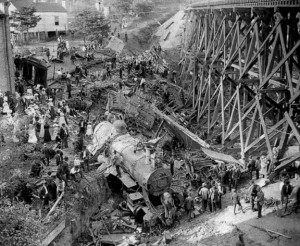 had been ordered to run as fast as possible to maintain the schedule. The railroad also claimed he descended the grade leading to Stillhouse Trestle at a speed of more than 70 miles per hour. Several eyewitnesses to the wreck, however, stated that the speed was probably around 50 miles per hour. In all likelihood, the railroad was at least partially to blame, as they had a lucrative contract with the US Post Office to haul mail…a contract that did include a penalty clause for each minute the train was late into Spencer. It is probably safe to conclude that the engineers piloting the Fast Mail were always under pressure to stay on time so the railroad would not be penalized for late mail delivery. And being under pressure can be deadly.
had been ordered to run as fast as possible to maintain the schedule. The railroad also claimed he descended the grade leading to Stillhouse Trestle at a speed of more than 70 miles per hour. Several eyewitnesses to the wreck, however, stated that the speed was probably around 50 miles per hour. In all likelihood, the railroad was at least partially to blame, as they had a lucrative contract with the US Post Office to haul mail…a contract that did include a penalty clause for each minute the train was late into Spencer. It is probably safe to conclude that the engineers piloting the Fast Mail were always under pressure to stay on time so the railroad would not be penalized for late mail delivery. And being under pressure can be deadly.
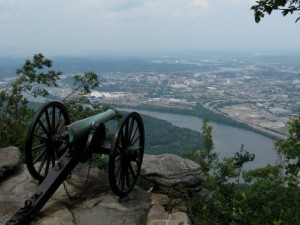
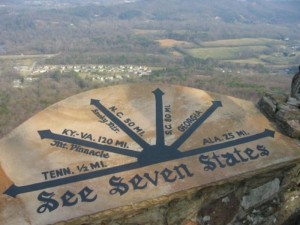 On a trip to Tennessee and the surrounding area in April of 2003, Bob and I had the opportunity to visit Lookout Mountain, which is located near Chattanooga, in southwestern Tennessee. The drive up was stunning, and everything we saw there from Ruby Falls, to the Incline Railway, and Rock City proved to hold amazing views as well. From the top of the mountain, you can see seven states…Tennessee, Kentucky, North Carolina, South Carolina, Virginia, Georgia, and Alabama. The view across that area is spectacular. When we travel, we love to go sight seeing, so this area fit right into our idea of a great place to visit. looking back now, I’m sure that time constraints played a part in my missing out on some of the amazing historical value of the area I was visiting, and to me, that is really a shame, because so much took place there, and I didn’t even know it.
On a trip to Tennessee and the surrounding area in April of 2003, Bob and I had the opportunity to visit Lookout Mountain, which is located near Chattanooga, in southwestern Tennessee. The drive up was stunning, and everything we saw there from Ruby Falls, to the Incline Railway, and Rock City proved to hold amazing views as well. From the top of the mountain, you can see seven states…Tennessee, Kentucky, North Carolina, South Carolina, Virginia, Georgia, and Alabama. The view across that area is spectacular. When we travel, we love to go sight seeing, so this area fit right into our idea of a great place to visit. looking back now, I’m sure that time constraints played a part in my missing out on some of the amazing historical value of the area I was visiting, and to me, that is really a shame, because so much took place there, and I didn’t even know it.
I suppose I should have known the history of the area, but apparently I wasn’t as up on my Civil War and Indian history as I am now. I really wish I had known or had at least taken more time reading the many signs in the area, because I could have figured out what a great area we were in. During the Nickajack Expedition which occurred in the 18th century, Lookout Mountain would become a last stand for the Chickamauga Cherokee, who were followers of Chief Dragging Canoe, who opposed the peace treaty between Native Americans and the American settlers. The peace treaty was signed in 1777. Most of the Chickamauga Cherokee agreed to the treaty, but a small band followed Chief Dragging Canoe, and they went to battle in the late summer through the fall of 1794. The final battle, and the point that Chief Dragging Canoe’s warriors would lose the fight took place on Lookout Mountain. The Indians were no match for the military might of the army, and after wounding only 3 of the militia, the villages of Nickajack Town and Running Water Town were destroyed, leaving seventy Cherokee dead.
The Civil War battle that made Lookout mountain famous took place on November 24, 1863 and was a part of the Chattanooga Campaign. Major General Joseph Hooker defeated the Confederate forces who were under the command of Major General Carter Stevenson. Lookout mountain has an excellent view of the Tennessee River, making it a perfect stronghold. It also held a perfect view of the Union supply lines, so if the Confederate army wanted to starve out the Union army, they needed Lookout Mountain, and if the Union army wanted to keep their supply lines clear, they needed Lookout Mountain. One of the hardest places to fight a battle is a mountain…at least for the side who is at the bottom of the mountain. They are far too visible to fight the battle easily. So, after calling for reinforcements, Major General Joseph Hooker went into battle. It was a must win situation. If they lost the Union soldiers would be starved into surrender.
Looking back now on our visit makes everything we saw seem much more interesting. In my memory files, I can pull out the different views of our visit to Lookout Mountain, and I can visualize the exact view the Confederate soldiers had, and knowing that there was virtually no place to hide, I can’t help but wonder how the Union soldiers managed to win that battle. I suppose that it was partly the numbers of soldiers, with 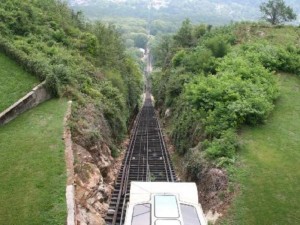
 the Union having more than 1,000 more, but more importantly, I think it was the fact that they surrounded the Confederate soldiers, leaving them with too many sides to cover. Our trip to Lookout Mountain, Ruby Falls, and Rock City has taken on a whole new meaning for me. I wish I had known it then. I would have really enjoyed that stroll through history. The great thing is that my pictures, memories, and a little look at history can take me back to visit again.
the Union having more than 1,000 more, but more importantly, I think it was the fact that they surrounded the Confederate soldiers, leaving them with too many sides to cover. Our trip to Lookout Mountain, Ruby Falls, and Rock City has taken on a whole new meaning for me. I wish I had known it then. I would have really enjoyed that stroll through history. The great thing is that my pictures, memories, and a little look at history can take me back to visit again.

